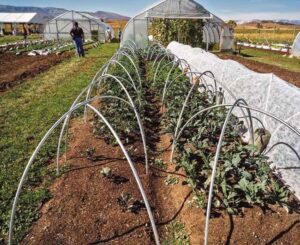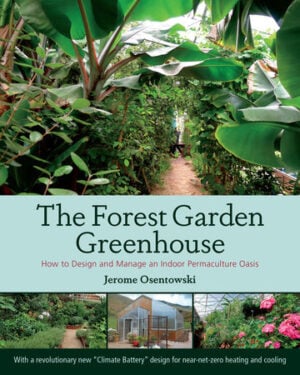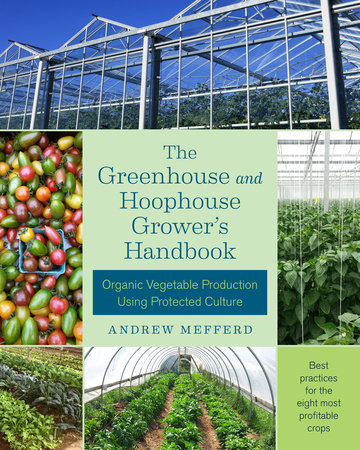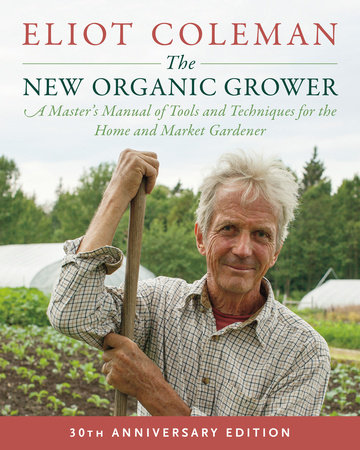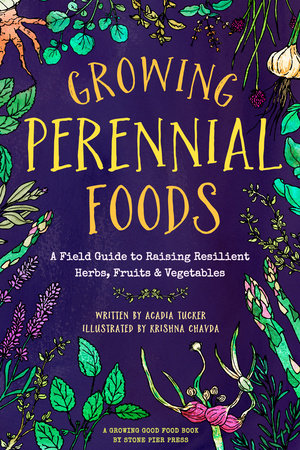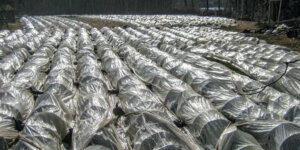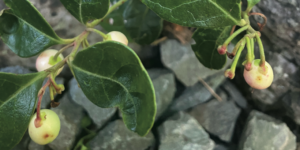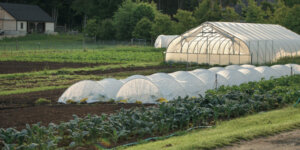Extend Your Growing Season with Crop Protection Structures
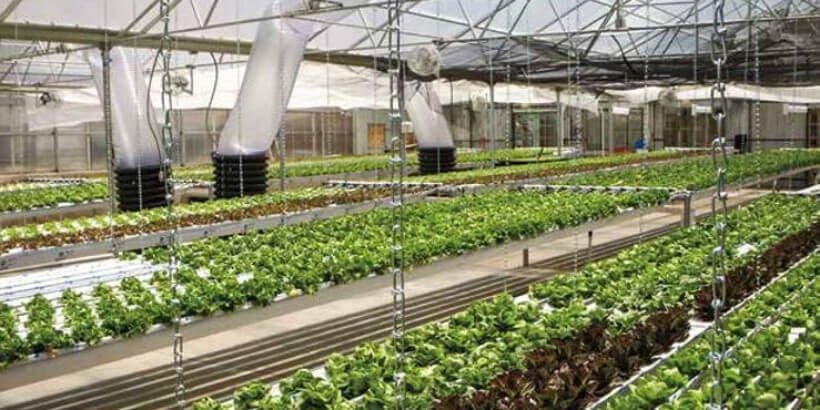
Conserve your resources and enjoy fresh produce all year long by growing your own food in the winter months! Achieving a twelve-month growing season is as simple as using the right type of crop protection structure for your climate.
The following is an excerpt from The Forest Garden Greenhouse by Jerome Osentowski. It has been adapted for the web.
A Guide to Crop Protection Structures
For a future dependent on renewable energy and constrained supplies, we need to conserve as much as we can. Growing a wide variety of food crops locally will save transportation energy, keep resources within the community where they are generated, and help create unique regional cuisines and artisan cultures. Let’s get growing!
Cloches and Row Covers for Crop Protection
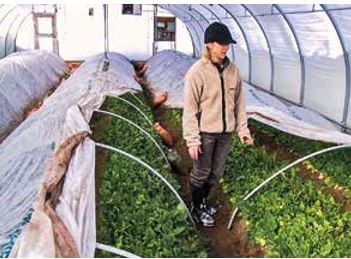
Sunlight passes through the white fabric to nourish the plants, and heat builds up in the soil to keep them warm at night. This can even provide 4 degrees of frost protection (at 29 degrees outside, the plants inside the cloche will remain around 33 degrees).
How Cloches and Row Covers Work
The fabric can be supported on sticks in the soil when the seedlings are young. And as the cover is very light, the plants will lift it as they mature and spread out. Using heavy wire or thin plastic pipe, you can create a “hoop” cloche that will support the fabric above the seedlings, providing them ample sunlight and air space for growing.
When the danger of frost is past and your plants are ready to be in direct sunlight, you can remove the fabric during the day, tucking it in again for the night. Eventually you can leave it off at night as well, until the danger of frost returns in the early autumn.
Here in the Rocky Mountains, we are typically able to keep summer squash and even melons protected from frost well into October using cloches. This allows us to extend the normal three-to four-month growing season to five or six months.
Crop Protection: Hoop Houses or High Tunnels
These structures are like cloches except that you can walk under them. They are often used over cloches to gain another layer of protection. In our Rocky Mountain climate, this would push the growing season out to seven or eight months, or even to twelve months with a climate battery and winter planting of cold-hardy greens.
Sunny sites in USDA zones 6 and warmer will be able to grow year round using this combination. In warmer outdoor zones, hoop houses support an ever wider variety of crops through the winter.
Hoop House Kits
There are many examples of hoop houses, or “high tunnels” as they are also called, which you can buy as kits and erect yourself. The model shown in figure 2.05, with the cloches in the foreground, is called a “Rolling Thunder” greenhouse, made by Rimol Greenhouse Systems in New Hampshire.
This is the high tunnel inspired and favored by Eliot Coleman of Four Season Farm in Maine because it rolls on rails, allowing him to start a crop under the structure, move the hoop house to the next space when the first crop is ready to grow outside, and start another crop under cover again. Instead of propagating plants in a greenhouse and moving the plants outside, the Rolling Thunder greenhouse makes it easy to move the structure.
Hoop House Ventilation and Insulation
Most hoop houses use natural ventilation by providing roll-up sidewall covers, but a few of them have vent openings along the top where the heat collects. If you use one without a top vent, the structure will be cheaper to buy, but you may have to install high-volume fans to keep the hoop house cool in the hottest months of summer. Shade cloth and other light-scattering covers can also be applied to reduce summer solar heat gain.
Hoop houses may be fitted with double-inflated poly greenhouse film over the frame for additional insulation value in cold climates.
This method involves stretching two layers of plastic film over the hoop house frame, sealing all edges of both layers together with continuous clamps to the frame, and installing fans to inflate the air space between the layers of film. The still air between the layers increases the insulating value of the cover.
Covering Your Hoop House: Panels
You may also cover the roof of your hoop house with rigid polycarbonate panels. These are more expensive, but they last longer and can provide a better insulating value than film.
Even on a hoop house covered with double-inflated poly, the end walls are often finished with polycarbonate panels because these flat, rigid surfaces are easier to fit with swinging or sliding doors than is film. You can easily mix double-inflated poly film roof covering and rigid polycarbonate panel end walls on the same structure.
Hoop House Notes & Considerations
A farmer, realizing success from longer growing seasons with a hoop house, might want to buy another but would soon discover one of the disadvantages of simple hoop houses: They can’t be connected side to side to make a large space like gutter-connected greenhouses can. In snow country, hoop houses and high tunnels must be separated far enough to allow snow to collect between them when it slides off the roofs.
Lightweight greenhouse structures must be designed to shed snow, which could otherwise collapse them. And this snow must go somewhere on its own. Even if they could support the weight, simple hoop houses don’t have gutter connections that would collect snowmelt.
The result is that the grower can only enter each hoop house from an end. It may be possible to gang multiple structures end to end, but this makes for very long working paths. Even with lateral separation, the architecture of the hoop house makes it much more like a tunnel than a large sunlit warehouse.
We dream of a hybrid system between the economy of the hoop house and the flexibility and water catchment of the gutter-connected greenhouse system.
Geodesic Dome Greenhouses for Crop Protection
Buckminster Fuller invented the geodesic dome, an extremely efficient form from both energy conservation and structural performance perspectives. The dome relies on triangular and spherical geometries to create an enclosure that will support heavy loads of snow with a great deal less material than a conventional rectilinear structure.
A spherical shape also has the advantage of enclosing the maximum volume of space with the minimum surface area, making the dome the most naturally energy-efficient shape possible. This combination of structural and energy-conservation efficiencies makes the geodesic dome an ideal greenhouse.
History of the Dome
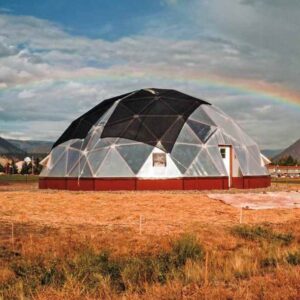
That greenhouse experiment went on for most of a decade until the grant funding ran out. The people operating it then applied what they had learned to develop better indoor growing systems in other settings.
Dome Greenhouses: A New Beginning
One of these is Udgar Parsons, who was the production manager at Windstar. He began building greenhouse domes in 1989 in the Roaring Fork Valley under the company name Growing Spaces, LLC.
He and his wife Puja moved their operation to a factory in Pagosa Springs, Colorado, in 1995, where they continue to build six sizes of their Growing Dome. These range from 15 feet to 42 feet in diameter, satisfying year-round growing needs for families, schools, and community groups.
Benefits of Domes for Crop Protection
Domes have significant advantages in the real world of energy conservation. I like to think of the material savings this way: a 42-foot-diameter dome covering 1,400 square feet of growing space uses less wood than is in the bottom two layers of logs in a 1,400-square-foot log home! And the material it does use is of smaller dimension, making it much more economical to build.
A dome is extremely wind resistant because of its aerodynamic shape. The force of consistent high wind is distributed uniformly over the triangulated frame, holding the structure down rather than blowing it away. Rectangular framed greenhouses require heavy trusses and significant cross bracing to maintain their structural integrity under large wind loads; this construction makes rectangular greenhouses inherently more expensive.
Finally, the dome geometry provides a cover with minimal surface area and maximal volume, making it the most energy-efficient enclosure we can create. Any other shape will have a higher surface-area-to-volume ratio, resulting in more heat loss to the outdoors. One disadvantage is the potential for increased breakdown and maintenance because of the large number of seams between triangular glazing panels.
Recommended Reads
Recent Articles
Want to grow year-round, but a greenhouse feels like a big investment? When it comes to cost and flexibility, low tunnels are the all-around winners.
Read MoreWintergreen is the stunning evergreen groundcover that’s a game-changer for your garden! It’s cherished for its aromatic leaves, vibrant fall color & bright berries.
Read MoreGrow winter carrots for a sweeter & more flavorful harvest! Ditch the bland, store-bought carrots this winter! Grow your own winter carrots for a sweeter and more flavorful twist 🥕🥕
Read MoreSearching for the perfect book to give the homesteader in your life? We’ve got your go-to books for anyone interested in organic growing, permaculture, soil health, year-round growing & more! What’s their next great read?
Read MoreWinter is coming… but that doesn’t mean you should put away those tools just yet. Extend the growing season well past the first frost!
Read More

